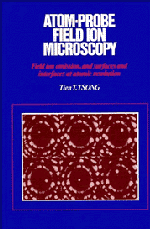 Atom-Probe Field Ion Microscopy
Atom-Probe Field Ion Microscopy 2 - Field ion emission
Published online by Cambridge University Press: 30 October 2009
Summary
Field ionization
Basic mechanisms and field ionization rate
Field ion images are formed by field ionization. Without this process there would simply be no field ion microscope. Field ionization is therefore the most important physical process in field ion microscopy. Theories of field ionization actually preceded field ion microscopy by over twenty years. In 1928, when quantum mechanics was still in its infancy, Oppenheimer found by detailed quantum mechanical calculations that under a field of about 2 V/Å the electron in a hydrogen atom could tunnel out of the atom into the vacuum. This is one of the earliest theories of quantum mechanical tunneling phenomena. In the same year Fowler & Nordheim used the quantum mechanical tunneling effect to explain field emission phenomena, and Gamow, Gurney and Condon also explained α-particle decay by tunneling of helium nucleus out of a heavy nucleus. These theories represented early triumphs of quantum mechanics outside of atomic systems. Tunneling from excited states of hydrogen atoms was treated by Lanczos to explain field induced quenching of spectral lines in Stark effect at a field near 106 V/cm, the highest attainable in gaseous discharge tubes. Gurney considered inverse tunneling in the much higher fields that were encountered in the cathodic neutralization of H+ ion in an electrolyte, and was already discussing how the atomic level would line up with the electronic levels, including the Fermi level, of the electrode at different distances. Although these studies were probably known to some of the early pioneers in field ion microscopy, there is no evidence that they directly influenced the early development of the field ion microscope.
- Type
- Chapter
- Information
- Atom-Probe Field Ion MicroscopyField Ion Emission, and Surfaces and Interfaces at Atomic Resolution, pp. 10 - 102Publisher: Cambridge University PressPrint publication year: 1990
- 2
- Cited by
